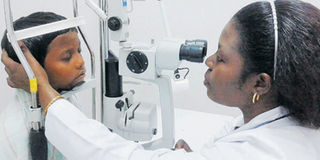When blindness means you’re diabetic

An eye specialist could refer you for diabetes screening. PHOTO | FILE
What you need to know:
- The human eye serves this purpose through its structural and functional arrangement.
- That’s why loss of vision has been a devastating experience to most people who have been diagnosed.
Eyes are the windows to the soul, so they say, and good vision is an essential component in daily life.
The human eye serves this purpose through its structural and functional arrangement.
That’s why loss of vision has been a devastating experience to most people who have been diagnosed.
A section of these people may have ended up blind for some other reasons but today, I want to talk about those who have lost their ability to see because of diabetes, better known as diabetes mellitus (DM).
You might have heard about this topic before but may be you aren’t aware when you should screen for the condition. But, let’s first look into the details of the disease. DM, is a medical condition that impairs the ability of the body to control blood sugar; is responsible for vision loss among adults aged 20-74. These are global statistics.
The main diabetes-related medical problem I am referring to here is known as diabetic retinopathy. This occurs when there is damage to the retina of the eye.
It ranks 5th among the top most common causes of preventable blindness, studies show.
What happens is that there impairment of blood vessels and nerves that lead to the retina, a thin layer that lines the back of an eye.
It’s this retina that is responsible for converting light rays into what we see.
When a person is diabetic, it, means that he has uncontrolled blood sugar; and this part of the eye, the retina, may not function properly.
In cases where the patient’s sugar remains uncontrolled for a long time, this may result in the damage to small blood vessels in the eyes.
Among them are the ones in the retina. This results in the inability of the nutrients and oxygen to be delivered to the retina.
The damage that later results in blindness occurs as a stage by stage process until symptoms of visual impairment begin to appear.
Anyone with diabetes is at risk of developing this blinding condition.
Dealing with ‘source of all evils’
Since diabetes is the one that leads to complications such as blindness; there is need to deal with the “source of all evils.”
And here, diabetes is the main problem. However, there are risk factors that one must avoid so that a diabetic patient doesn’t reach this stage.
Cigarette smoking: Smokers with diabetes have higher risks for serious complications, including: heart and kidney disease. Diabetic retinopathy is one of the complications.
Poorly controlled blood sugar: If this remains a problem for a long time, the duration of diabetes may in itself cause complications. It’s important that a diabetic patient observes the doctor’s instructions on medications, tests the blood sugar as required and intervenes whenever necessary.
At one point, the uncontrolled blood sugar may go as far leading to high blood pressure and kidney problems.
But then at what point does one turn blind?
For the diabetic patients, loss of vision usually comes as a late symptom. In most cases, it comes to a point where treatment may not be so effective in restoring vision.
But there are things to note, as signals to the problem.
Blurry vision, trouble telling colors apart, dark or floating spots and trouble seeing things that are at the center of your focus when reading/driving are some of the symptoms.
Therefore it is important for a diabetic patient to undergo screening for diabetic retinopathy so as early changes detected maybe intervened appropriately.
The American diabetic association recommends the following schedule.
Type 1 diabetes to be screened within 5 years after diagnosis of diabetes once patient is age 10 years or older and then follow up yearly.




